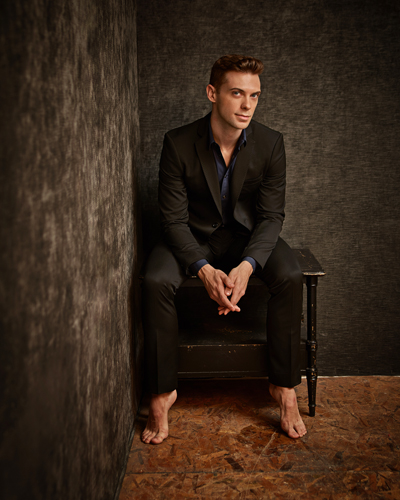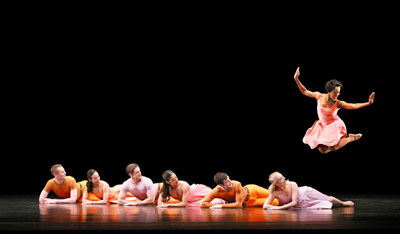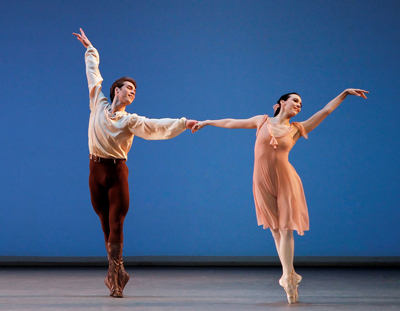Dance: A Backward Glance: Taylor and Robbins
By Dawn Lille
arttimesjournal September 25, 2018
 Michael Novak
Michael Novak(photo: Bill Wadman) |
Before embarking on the new season of performance that September traditionally marks, it seems worthwhile to reflect on two highlights of last season: Paul Taylor and Jerome Robbins.
Paul Taylor died at age 88 while this article was being written, which made commenting on his company’s annual New York season last March especially poignant and relevant. It was the last chance to actively connect with one of the greatest American modern dance choreographers. His wit, musicality, ability to fantasize and intuitive understanding of the depths and heights of the human species were encompassed by his sense of form.
Taylor lived life his way, often an iconoclastic one. He thought about the fate of his company and his numerous dance works after he was no longer here. Recently he began presenting the dances of his predecessors and contemporaries, thereby preserving them, and welcomed younger choreographers, often commissioning new works. He chose his successor as well. Last spring Michael Novak, a 35 year old critically admired member of the company, was named Artistic Director Designate and on July 1 he began his apprenticeship , which was so brief.
Among the many evenings of exuberant, satisfying and thought provoking movement by the extraordinary Taylor dancers, one that stands out was called 'Icons" of Modern Dance, a term that can be roughly defined as a symbol or person worthy of veneration.. On the program were three pieces: Set and Reset danced by the Trisha Brown Dance Company, Dances of Isadora, performed by Sara Mearns and Taylor's Esplanade.
Set and Reset was created in 1983 by Trisha Brown, who died last year. She was an influential choreographer who, in the sixties, started inventing her own technique and approach to movement that was very connected to the graphic arts. Her unique concept of both gesture and space influenced many.
This work, to music by Laurie Anderson, has visuals and costumes by Robert Rauschenberg, who also designed the lighting in collaboration with Beverly Emmons, and was a true collaboration. The costumes contain a subtle black and white print that recalls Rauschenberg's early lithographs.
The movement, repetitious yet incessantly changing, creates a landscape that constantly involves the viewer. Brown used improvisation to create the piece so that it would always look spontaneous, with the waves of movement coming from the body's core, but the choreography is set. Yet the sense of constant reinvention remains..
Ten of Isadora Duncan's short pieces to music by Chopin, Brahms and Lizst were directed and staged by Lori Belilove and performed by Sara Mearns. Before viewing,, the question was, could this work, choreographed by the early dance pioneer considered the mother of modern dance, who stated that she could not imagine the goddess of liberty dancing ballet, be successfully performed by an acclaimed ballerina. The answer is a resounding "yes" Mearns is delicate and outstandingly beautiful in this role and did not look like a classical dancer. She demonstrated the relevance of this work. A differently trained body in a different time, neutrally preaching the philosophy of movement, can still resound deeply with an audience.
 Esplanade
EsplanadePaul Taylor Dance Company |
The final icon on the program was Esplanade, Taylor's 1975 creation to music of J.S. Bach played live by the Orchestra of St. Luke's conducted by Don York. This dance, for nine performers, is an ongoing stream of pedestrian movement - walks, runs, skips, hops, slides, falls - performed as solos, duets, trios and group endeavors.. It has crescendos and denouements, with emotions ranging from childlike and playful, to joyful, to erotic, to lonely, to deeply sad. The program claims it is one of the greatest dances ever made, which may well be true. Taylor and Esplanade are both uncontroversial icons.
2018 marked the 100th anniversary of the birth of Jerome Robbins, an event celebrated throughout the world. The New York City Ballet festival, "Robbins 100," featured 19 of his works. As cofounding choreographer of the company with George Balanchine, Robbins' work has long been an integral part of the troupe.
One of the things Robbins and Taylor had in common was their understanding of what makes American dance American and both surely understood the sense of freedom and spirituality Duncan espoused. Both were also greatly admired by Balanchine.
 Jenifer Ringer and Gonzalo Garcia in
Jenifer Ringer and Gonzalo Garcia in Dances at a Gathering© Paul Kolnik |
The various ballets on the programs I saw included Danes At A Gathering, the one hour 1969 work to 18 of Chopin's piano pieces.. The use of the word "dances" suggests to me that it is about different dancing individuals (10), who, in the course of the work perform short sections of various groupings that evolve into their own special community or "gathering." Every viewing of this ballet reveals something new.
Seeing it again I was amazed at how Robbins used the music. Sometimes one heard the notes and they seemed to form atmospheric clouds in which the performers were moving. The resulting theater, peopled by distinctive characters, took one into another dimension. And at the end of each evening of Robbins' work, complete strangers walking down the stairs of the theater started to talk to each other. Taylor and Robbins had much in common and, hopefully, both will continue to influence future generations of dance creators and viewers through their still relevant and iconic works.
dawnlille@aol.com
